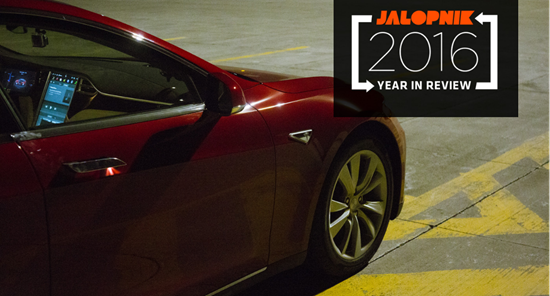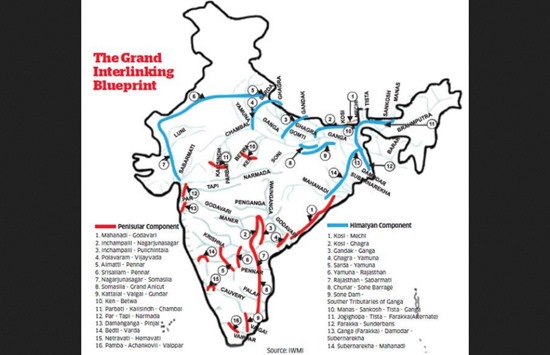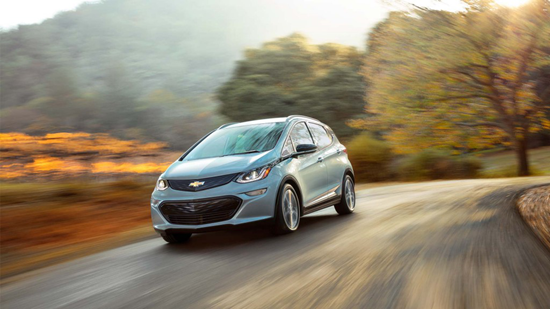
The Biggest Car Technology Stories Of The Year And What's Next
By Ryan Felton, Jalopnik, 28 December 2016.
As this whirlwind pile-of-shit year comes to a close, it’s probably best to remember that, if you squint hard enough, a silver lining can appear and make you forget momentarily the imminent doom that lays ahead. 2016 was all about the continued convergence of the auto and tech sectors, and what’s coming next will be big for the brimming autonomous market - and may bring some hope for us drivers, too.
But in 2017, the viability of some startups remains in flux, while the future of autonomous technology again promises to be front-and-center throughout the year. At least the car industry has some sense of what to expect after the new year. The rest of us aren’t so lucky.
1. The First Fatality in a Self-Driving Car
View of a Tesla Model S in its self-driving mode. Photo credit: Raphael Orlove.
The driver, 40-year-old Joshua Brown, crashed into the trailer’s high side, which broke through the windshield of the Model S. Brown, a former Navy Seal, had previously recorded a video where he said the vehicle saved his life from a collision.
Brown’s death, expectedly, drew wide attention for being the first known one in an autonomous vehicle. Tesla stressed in a statement at the time that it disables Autopilot by default and “requires explicit acknowledgement that the system is new technology and still in a public beta phase before it can be enabled.”
When drivers activate Autopilot, the acknowledgment box explains, among other things, that Autopilot “is an assist feature that requires you to keep your hands on the steering wheel at all times,” and that “you need to maintain control and responsibility for your vehicle” while using it. Additionally, every time that Autopilot is engaged, the car reminds the driver to “Always keep your hands on the wheel. Be prepared to take over at any time.” The system also makes frequent checks to ensure that the driver’s hands remain on the wheel and provides visual and audible alerts if hands-on is not detected. It then gradually slows down the car until hands-on is detected again.
News of the crash didn’t emerge weeks later, in June, and soon after two federal agencies got involved in investigating what took place. Consumers Report urged the company to disable the software, saying it was “too much autonomy too soon,” but Tesla’s founder and true starboy Elon Musk has consistently defended the feature and promised to roll out an “Enhanced Autopilot.” But the updated feature has been delayed, and Musk said last weekend that it was “getting close” to making it a reality.
2. Near-collision With (Potentially) An Uber Self-Driving Car
Uber claimed the vehicle wasn’t part of a self-driving pilot program in San Francisco, but by the looks of this video, it sure seems to be the case. A few hours after the ride-sharing giant’s program began, one of its Volvo XC90s, equipped with seven cameras and laser detection systems, seemed to have busted through a red light on a busy street.
Uber blamed the driver on the incident, but the company wasn’t in need of any hiccups. After the company that’s literally valued at $69 billion declined to pay a meager $150 California state permit to drive an autonomous vehicle on the road, regulators ordered the program to shutdown. Uber said fuck it, and kept things rolling anyway, because that’s how Uber operates. On Wednesday, California made good on its ultimatum, announcing the company’s registrations for Uber’s 16 self-driving vehicles had been revoked.
Soon after, Uber confirmed it was temporarily suspending the program, telling BuzzFeed that it remains “100% committed” to California, and suggested it was looking elsewhere to re-deploy its fleet. So, things are...not so great for Uber.
3. More Driverless Testing On Public Streets, But What About Bad Weather?
While a near-collision on day one isn’t as catastrophic as a full-blown accident, Uber’s future more and more seems contingent on the success of the pilot program in California and another in Pittsburgh, and future expansion of self-driving efforts. But who knows how long that’ll take. Speaking of the Pittsburgh effort, the Uber vehicles there were blamed for raising all sorts of hell, but it appeared to be more of human-error than anything. See, silver linings.
Back in sunny California, Tesla sought to push back against the haters and touted a video that aimed to show one of its vehicles navigating a “complex urban environment.” What actually emerged was a slick production set to The Rolling Stones, showing a car cruising about town in near-idyllic California conditions. Which, that’s OK.
As we said at the time, we’ve tackled hundreds of miles seamlessly with Tesla’s Autopilot engaged. But the video was basically much of the same. It’s cool to see more self-driving action on the road, but it’ll be far-more impressive - and worth the hype - when a vehicle’s shown navigating through a driving rainstorm.
The new Pacifica Hybrids developed by Fiat Chrysler didn’t hit the road this year, but the company unveiled the Hybrid minivan concept, and said 100 were made as part of a deal with Google. The vehicles are being outfitted with self-driving technology and expected to be tested next year.
4. Waymo (Whatever That Means) And Way More
Speaking of Google, the company was reportedly ready to throw in the towel for making a self-driving car on its own, and planned to work with traditional automakers. Earlier this month, it rolled out plans to rename the project something a bit more in-your-face and weird: Waymo. It’s hoping to do Way-mo (I’m sorry).
The company announced the move in San Francisco with Waymo’s new CEO John Krafcik, who jointed the project from Hyundai. Spinning off the self-driving efforts into its own company effectively staked out the long-term goal of commercializing the autonomous technology.
With the build-out of the Pacific Hybrids underway, it’s expected that we’ll hear way more (god, I’m so sorry) about Waymo in 2017.
After a turbulent period that reportedly brought layoffs for hundreds of engineers, the company said it set a deadline of late 2017 to prove the feasibility of its self-driving car technology and decide on a final direction. At this point, it seems like a crapshoot to think the project will succeed - but we’ll see. Apple’s too big and probably too smart to be written off entirely.
5. Crossover Boom Meets EVs
As we noted last month, the way to lure hesitant consumers to electric vehicles amid the current SUV sales boom may be just to start producing crossovers. Mercedes and Jaguar picked up on that line with a pair of concepts that easily would’ve been sedans a few years back.
Mercedes rolled out the new “EQ” brand, and lordy does the initial “Generation EQ” concept pack a punch. Mercedes’ chief Dr. Dieter Zetsche said the wild-looking vehicle will be in production by the end of the decade, and it’s expected to house two electric motors, producing a range of up to 310 miles. And at 400 horsepower, it will not be wanting for speed. Mercedes says it wants to have 10 fully-electric cars offered by 2025, when it hopes to have 15-25 percent of global sales comprised of EVs.
Meanwhile, Jaguar unveiled the I-Pace concept, supposedly close to a production variant in typical Jaguar Land Rover fashion. That’s good because it looks superb.
The company announced the car at the LA Auto Show, and it’s aiming to be the brand’s first fully-electric vehicle in 2018. The I-Pace is powered by a 90kWh lithium-ion battery pack, sending the juice through two electric motors, all with a supposed range of over 220 miles. With roughly 400 horsepower and 516 lb-ft of torque, the zero to 60 mph time is in the ballpark of four seconds. And a basic 50 KW DC charging network should charge the vehicle in about two hours, according to Jaguar.
These moves are clearly the electric future for both brands, and could signify that we’re beginning to witness the accelerating-dominance of crossovers. Both are very Tesla Model X-ish, but with the scale and production abilities of these two giant established players, they could be real contenders in the EV world.
6. More Vehicles Talking And Doing More Stuff
If you have an Audi, and you’re driving in Las Vegas in the near-future, you’ll probably now have a moment to spare at red lights to read a text or reach for something behind your seat. The company announced its Traffic Light Information technology will allow some of its vehicles-initially, the Q7 and A4 all-road models - to chat with nearby traffic lights. The “talk” function will signal to drivers when the light is about to turn green.
Audi said the car receives real-time signal information from the traffic management system that governs traffic lights to work its magic. The company also hopes to expand to other cities beyond Las Vegas in the coming years, but it’s unknown how soon that’ll happen.
Eventually, Audi wants the system to offer “speed recommendations designed to maximize the number of green lights one can make in sequence,” because we know how fulfilling it is to not hit a single red light on a drive.
In another hopeful sign, the U.S. Department of Transportation also stepped up efforts to deploy more vehicle-to-vehicle technology, and expects to introduce a rule soon for V2I technology, so transit planners can “integrate the technologies to allow vehicles to ‘talk’ to roadway infrastructure such as traffic lights, stop signs and work zones to improve mobility, reduce congestion and improve safety.”
The DOT says vehicles with automated driving functions like emergency braking and adaptive cruise control would benefit from an increase of V2V data “to better avoid or reduce the consequences of crashes.”
7. Faraday Future (Barely) Hangs On
If there needed to be a winner crowned for most-bizarre car story of 2016, Faraday Future likely gets the nod. The earnest and ambitious start-up burst onto the scene in 2015, and quickly fizzled out by this year’s CES, when it unveiled more of a Dark Knight-looking pipe dream concept than anything resembling a production-ready vehicle.
Jia, whose LeEco business is described in an absurdly ambiguous manner as FF’s “strategic partner,” also apparently asked had FF take time away from developing its own vehicle to design a separate project - that is, the LeEco car. Nice.
Well, if CES goes bad next month, and it doesn’t unveil something even remotely resembling a buyer-ready car, we’ve already been told FF is done.
8. Can Lucid Motors Pull It Off?
On the flipside, another EV startup called Lucid Motors (which also has Jia Yueting as a financial backer) is apparently taking a cooler approach to their hopeful EV offering, but while its Air model is sleek, the company said it’ll produce 1000 HP, which sure, maybe?
With a claimed range of 400 miles on a single charge, however, the Air would certainly be nothing short of remarkable. If it makes it to production. Still, Lucid so far seems - how do I put this, less full of shit than others. They’ll be one to watch in 2017.
9. Give Me Your Data
With all of this data, there’s a potentially-colossal industry afoot, as well. McKinskey & Co. released a report this year that suggested car data could be the makings of a $750 billion industry.
The former chief technology officer at Cisco Systems and Motorola tells them that’s good, but not sufficient.
“Because of the heritage they have, it’s hard to say, ‘How can I build this from ground zero?’” Warrior said in an interview at the L.A. Auto Show. “They are trying to look at it as, ‘Can I just get the software and put it on an existing hardware platform,’ and I’m [making] the point it never works that way.”
The full package will come together for some, technologists say. But their concern is that the likes of Ford, Toyota and others are underestimating obstacles. What seems five years away could be 10 years out, and business and strategy executives are jumping the gun on technology development teams.
“To implement data-based business models, cars need to look like cellphones,” said Josh Hartung, chief executive of automotive software start-up PolySync.
The McKinsey report said that roughly 30 data-related business opportunities could produce up to $750 billion - really, that’s with a b - in annual revenue worldwide by 2030.
10. EVs Go Mainstream Too
As the year passed, it became obvious that EV-makers are eager to get a palatable vehicle into consumers’ hands. At this year’s Paris Auto Show, Volkswagen touted an EV that would be somewhere in the mid-$20,000 price range, with a claimed range of up to 250 miles. Tesla’s Model 3 is a bit more expensive, but not nearly as prohibitive as some models may have been before.
General Motors’ is also intent on making the Bolt work, and has plans - thanks to GM’s home state welcomed autonomous-car testing with open arms in 2016 - to do self-driving tests and work with the automaker’s ride-sharing investment, Lyft.
Even with a electric-centric future being envisioned, are consumers down? EV sales are actually up in 2016, even though automakers aren’t marketing them hard. But gas is still cheap, so if that trend continues is something to watch for in 2017.
11. Automation In The Trucking Industry
Automation and the trucking industry seem like a marriage made to prevent long-sleepy drives for truck drivers, but there’s some fear in what’s possibly going to transpire. Some in the industry have raised concerns about displacing drivers themselves, but that’s likely - if even plausible - decades out from happening.
Chris Spear, president of the American Trucking Association, told federal lawmakers earlier this month that drivers, for instance, will still be needed for pickups and deliveries. From The Detroit News:
“What we’re really talking about is not displacing drivers: I think you’re always going to need drivers in trucks in the cityscapes to do the pickups and deliveries,” Spear told a panel of U.S. lawmakers during a Tuesday roundtable on the future of autonomous vehicles that was organized by the House Transportation and Infrastructure Committee.
“If you equate it to pilots - you still have pilots in the cockpit. They do the taxiing, they do the takeoff, they do the landing,” Spear said. “What we’re talking about is at cruising altitude hitting that autopilot button. For a trucker, it’s really the long haul. That’s where you really get the return on this kind of investment.”
But analysts have predicted that self-driving trucks could be rolled out at a far-quicker pace than cars, usurping the truck driver as early as within a decade. Of course, that’s not a complete overhaul. According to the News, Spears said it’s likely the near-future will have drivers monitoring a self-driving truck.
“I think we need to be a bit realistic,” Spear said. “We’re talking decades out. It’s going to take a long time for that to filter out of the mainstream marketplace.”
Top image credit: Raphael Orlove.
[Source: Jalopnik. Edited. Some images added.]



























![wps2AD3.tmp[6] wps2AD3.tmp[6]](https://lh3.googleusercontent.com/-pGcw_L9OSLg/WGcNG8ibNKI/AAAAAAAD6tA/6ueX4MA6ARg/wps2AD3.tmp%25255B6%25255D_thumb%25255B2%25255D.png?imgmax=800)





